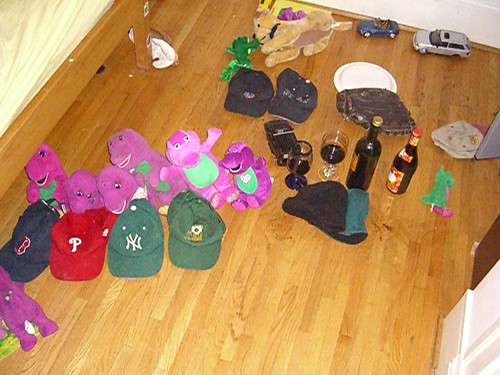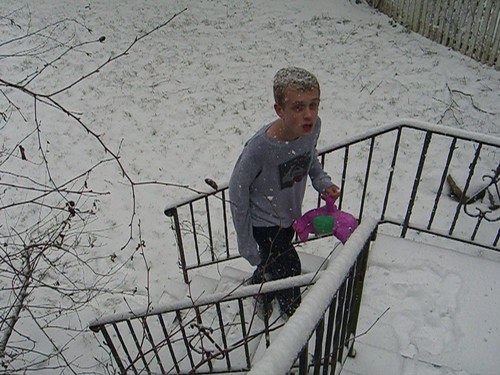Turns out this was what he was up to. You can see the two wine glasses over to the right, both filled with vinegar. I suppose if he knew how to use a corkscrew they'd be filled with wine. (Unless he thinks Ed and I are drinking glasses of balsamic vinegar with our cheese toasties, which I suppose is a possibility.)

Andrew got two new Barneys for Christmas.






11 comments:
Hi Catherine:
I have an autism question for you. Actually it's an Asperger question.
I have a student with AS who is a wonder at math, especially computation. He does 3 x 3 multiplication in his head and he is extremely fast at getting new concepts. It might even be that you could write a book about how his number sense plays into his ability to extend his mathematical knowledge.
Anyway, here's the question. He really struggles at drawing things like a polygon. I know he has some motor skills problems (it shows up in his almost unreadable lettering) but this goes beyond the motor skills. When I ask him to draw a triangle on grid paper he does fine with the base line. But when it's time for him to locate a vertex above the line (especially when it's not a right triangle) he can't seem to count or locate the points on a vertical axis.
For example if he has to count over (horizontal) 2 and then up four (vertical), he'll count over fine but when it's time to go up he sort of resets to the starting point before going up and then counts up incorrectly. It's like he can only draw right triangles or rectangles, never obtuse or acute triangles and never a parallelogram. He almost never gets the height correct because of this.
I've worked with him, even so far as guiding his hand but nothing seems to break through this problem. Any ideas?
What a terrific Christmas representation by Andrew! Isn't that what the Holidays are all about? Get together all the people that mean the most to you in a single room and have some wine together. Or something like that.
Paul -- have you tried "flipping" the drawing problem? Start at the top and then connect down, rather than draw the baseline first and try to move up? Your student is getting stuck after he draws the base, so maybe draw the base last? Or locate and identify all the points of the triangle before drawing any of the lines?
Your student is very lucky to have you as a teacher; too many teachers just give up with AS students and justify it by saying, "He has AS and so he can't do this." I like your approach -- "He has AS, I need another way to teach him how to do this."
Good luck.
Hi Lynn:
Haven't tried upside down, duh? Sometimes you just can't see the forest for the trees.
His problems show up in attempts to draw the dots. I can't wait to see what he does upside down.
Thanks for the help.
I've worked with him, even so far as guiding his hand but nothing seems to break through this problem. Any ideas?
I hate to say it, but I have NO idea.
I'm going to give "Lefty" a hoot and see if she has thoughts.
Get together all the people that mean the most to you in a single room and have some wine together. Or something like that.
lolll!!
upside down is an interesting idea
Paul, have you ever looked at Betty Edwards work?
She's the drawing teacher - amazing.
She uses an exercise early on (not original to her - I've forgotten the author who invented it) where you turn a Picasso drawing upside down & copy it.
It turns out amazingly well - much better than if you'd tried to copy the drawing right side up.
I have seen upside down as a recommendation for learning to sketch. I tried it once on an egg. Not pretty, but then it was much better than my rightside up egg picture, which my wife found to resemble Mister Potatohead, so it does seem to work.
On topic.... I'm also going to try having him do all his horizontal work then turn the paper 90 degrees to do the vertical, keeping everything horizontal.
I'm sounding like the white rabbit with that sentence but you get the idea right?
I'm really interested to know what could underlie such an anomolous difficulty; is it visual, motor, some kind of symmetry thing, or maybe just a difficulty switching gears? He absolutely hates external pressure, preferring to pressure himself. It makes it really hard to work with him because he often interprets assistance as pressure. If you 'help' him with something that he subsequently does wrong he gets really frustrated with himself to a point where you have to back off and let him feel independent again.
Paul,
How old is the student? Has he ever tried plotting a point in cartesian coordinates? I am wondering if it might be possible to do an end-run around the polygon problem like so:
(1) Put polygons and other continuous figures aside for a while.
(2) Work on the (discrete) skill of plotting points in rectangular coordinates, relative to a fixed origin and pair of coordinate axes.
(3) Once has has got the hang of plotting points like, e.g. (3,7) and (5,2), return to the polygon case and see if it has made a difference.
In (2) I imagine you might find the same problem you have seen so far -- he "counts over" just fine, but then for the "counting up" part he resets to the vertical axis. If this happens, try using a "movable axis" -- draw a pair of axes on something transparent, e.g. overhead paper, and have him physically move the axes to the right during the "counting over" part. That could help him preserve the intermediate location as the starting point for the "counting up" part.
Actually, that latter strategy might help you even if you ignore my suggestion about plotting points and just keep working on triangles.
Another thing to be aware of is that using grid paper can be both a blessing and a curse. On the one hand it makes it possible to do exercises like this. On the other hand it can cause serious learning obstacles down the road: students have trouble drawing figures that don't have a "horizontal" base, or contain right angles. When I taught 9th grade geometry one quick activity I always did early in the year was to ask students to draw (on their grid paper) a triangle -- no further instructions. Then we compared notes. Usually 100% of the class would draw a triangle with a horizontal base on the "bottom", at least 2/3 drew a right triangle, and more than half drew an isosceles triangle. The next activity was to draw a triangle that had none of those properties. You'd be surprised at how hard some students found it -- the grid paper has such a powerful framing effect that suppressing it takes a real act of will.
Michael:
Thanks for the suggestions. I really like the movable axis. He can set it up anyway that is most comfortable for him then use it like a portable axis. Nice.
Agree on the framing. Lot's of kids have to fight the tendency to always make right triangles. I do everything on grid paper anyway. It has positive benefits in organization that offset that. We don't seem to spend enough time on the 'simple' drawing stuff.
Interesting collection. I notice a strong hat theme - any theories on what they represent?
Post a Comment